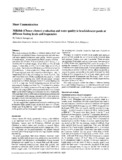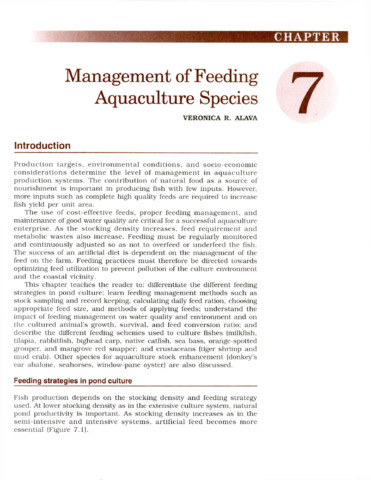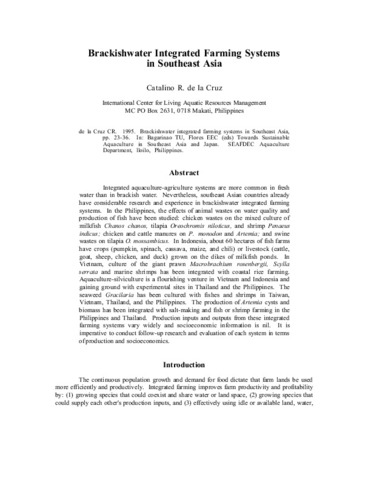Milkfish (Chanos chanos) production and water quality in brackishwater ponds at different feeding levels and frequencies
- Global styles
- MLA
- Vancouver
- Elsevier - Harvard
- APA
- Help

View/
Date
1998Author
Page views
3,332ASFA keyword
AGROVOC keyword
Taxonomic term
Metadata
Show full item record
Share
Abstract
This study evaluated the effects of different feeding levels and frequencies on milkfish (Chanos chanos) growth, feed efficiency, and water quality in brackish water ponds. Milkfish juveniles (average weight, 1 g) were stocked in 500 m2 ponds at 8000 ha-1 and reared for 132 days. Fish were fed daily after 34 days from stocking (initial average weight, 22 g) either at 3 % of body weight, 3 times daily; at 4 %, 3 or 6 times daily; or at 6 %, 6 times daily. There were no differences (α= 0.05) in production (780–960 kg ha-1), final weight (125–168 g), and survival (81–85 %) among treatments. Maximum feed ration (kg ha-1 day-1) ranged from 23.8 at the 3 % feeding level to 61.4 at 6 %. The feed conversion ratio (FCR) significantly increased (α= 0.05) in proportion to feeding rate, while the percentage nitrogen assimilated by milkfish decreased from 41 % at low feeding rate to 21 % at high rate. Partial budgeting analysis showed that increasing the feeding rate from 3 to 4 % resulted in a positive net benefit, but further increase to 6 % had a negative benefit.
Dissolved oxygen (DO) concentrations at dawn were always higher at the lower feeding level compared to other treatments. Although there were no differences in nitrogenous nutrients and total suspended solids among treatments, pH, total ammonia-nitrogen, and phosphorus increased and DO at dawn decreased with increasing biomass and feed input.
Results suggest that supplemental feeding for milkfish grown in brackish water ponds should not be more than 4 % of body weight and 38 kg feed ha-1 day-1 for maintenance of good water quality and for economical operation.
Suggested Citation
Sumagaysay, N. S. (1998). Milkfish (Chanos chanos) production and water quality in brackishwater ponds at different feeding levels and frequencies. Journal of Applied Ichthyology , 14(1-2), 81-85. https://doi.org/10.1111/j.1439-0426.1998.tb00618.x
Type
ArticleISSN
0175-8659Collections
- Journal Articles [1256]
Related items
Showing items related by title, author, creator and subject.
-
Aquaculture in the Philippines
Aypa, Simeona M. (Aquaculture Department, Southeast Asian Fisheries Development Center, 1995)Aquaculture is regarded as the most promising source of protein food in the years ahead. Milkfish and Nile tilapia are the major fishes now produced but groupers, sea bass, rabbitfish, red snappers, carps, and catfishes ... -
Management of feeding aquaculture species
Alava, Veronica R. (Aquaculture Department, Southeast Asian Fisheries Development Center, 2002)This chapter teaches the reader to: differentiate the different feeding strategies in pond culture; learn feeding management methods such as stock sampling and record keeping, calculating daily feed ration, choosing ... -
Brackishwater integrated farming systems in Southeast Asia
De la Cruz, Catalino R. (Aquaculture Department, Southeast Asian Fisheries Development Center, 1995)Integrated aquaculture-agriculture systems are more common in fresh water than in brackish water. Nevertheless, southeast Asian countries already have considerable research and experience in brackishwater integrated farming ...





